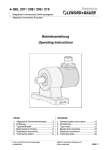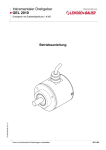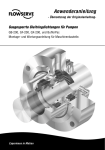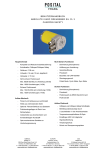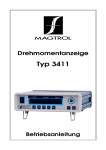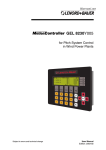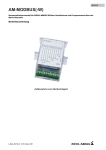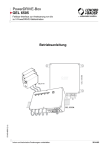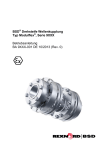Download GEL 260 Betriebsanleitung Operating Instructions
Transcript
GEL 260 Magnetisch-inkrementaler Drehgeber Magnetic Incremental Encoder Betriebsanleitung D-71B-260 (2.1) Operating Instructions Inhalt Contents 1. 2. 3. 4. 5. 6. 7. 1. 2. 3. 4. 5. 6. 7. Allgemeine Sicherheitshinweise ......... 3 Beschreibung ..................................... 4 Typenschlüssel .................................. 7 Montage ............................................. 8 Elektrischer Anschluss ....................... 9 Technische Daten ............................ 11 Maßbilder ......................................... 23 Irrtum und technische Änderungen vorbehalten General safety instructions .............. 13 Description....................................... 14 Type code........................................ 17 Mounting.......................................... 18 Electrical connection........................ 19 Technical data ................................. 21 Dimensioned drawings .................... 23 Right to technical changes and errors reserved. 2012-02 Lenord, Bauer & Co. GmbH Dohlenstrasse 32 46145 Oberhausen Germany Fon: +49 (0)208 9963-0 Fax: +49 (0)208 676292 Internet: http://www.lenord.de E-Mail: [email protected] 2 Doc. No. D-71B-260 (2.1) GEL 260 Betriebsanleitung Deutsch 1. Allgemeine Sicherheitshinweise Zur Erhaltung der Funktionsfähigkeit des Drehgebers unbedingt folgende Punkte beachten: Drehgeber nur über eine flexible Kupplung mit der Antriebswelle verbinden Drehgeber vor mechanischen Beschädigungen schützen (bei Einbau und Betrieb, siehe dazu die Handhabungshinweise in Kapitel 4). Einbau-, Anschluss- und Service-Arbeiten nur von qualifiziertem und geschultem Fachpersonal durchführen lassen, unter Berücksichtigung der einschlägigen Unfallverhütungs- und Sicherheitsvorschriften sowie der Angaben in dieser Betriebsanleitung. Drehgeber nicht öffnen oder auseinander nehmen. Notwendige Reparaturen dürfen nur von LENORD+BAUER oder einer davon ausdrücklich ermächtigten Stelle durchgeführt werden. Die in der Produktdokumentation angegeben Grenzwerte unbedingt einhalten. Buchstabenanordnung in der Steckerbelegung (Kapitel 5) beachten: Ein häufig auftretender Fehler ist das spiegelbildliche Anschließen von Leitungen an den Gegenstecker. Drehgeber nur bestimmungsgemäß verwenden: Die Drehgeber GEL 260 sind ausschließlich für Messaufgaben im industriellen und gewerblichen Bereich bestimmt. Mit ihnen können Positionen, Längen, Winkel oder Drehzahlen gemessen werden. Sie gelten als Zubehörteil einer Anlage und erfordern den Anschluss an eine spezielle Auswertelektronik, wie sie ein Positioniercontroller oder ein elektronischer Zähler enthält. Zur bestimmungsgemäßen Verwendung gehört auch, dass alle in der Produktdokumentation gegebenen Hinweise beachtet werden. Eine andere oder darüber hinausgehende Verwendung gilt als nicht bestimmungsgemäß. Für hieraus entstehende Schäden haftet die Firma LENORD, BAUER & CO. GMBH nicht. Hinweis in eigener Sache Die Betriebsanleitung wurde mit größter Sorgfalt erstellt. Es kann jedoch keine Gewähr für Fehlerfreiheit übernommen werden. Die Betriebsanleitung ist bestimmt für den Betreiber bzw. Anlagenbauer sowie dessen Personal. Bitte bewahren Sie sie sorgfältig auf, so dass sie auch für einen möglichen späteren Serviceeinsatz am Drehgeber zur Verfügung steht. Bei Weitergabe des Gebers an Dritte bitte auch diese Betriebsanleitung mitgeben. GEL 260 3 Deutsch Betriebsanleitung 2. Beschreibung Einsatzbereich Die Drehgeber GEL 260 sind robuste Signalgeber für die Messung von Rotationsbewegungen oder Positionen. Sie sind für den Einsatz in rauer Umgebung geeignet, da sie eine hohe Beständigkeit gegen Betauung, Spritz- und Kondenswasser sowie einen großen Temperaturbereich von 0 °C bis +70 °C, optional sogar von -20 °C bis +85 °C aufweisen. Ausgegeben werden diverse Rechtecksignale (siehe Signalmuster weiter unten), die eine eindeutige Richtungserkennung zulassen und – im Fall von optionalen inversen Signalen – eine hohe Datensicherheit garantieren. Ein optionaler Referenzimpuls kann zum Referenzieren der Anlage herangezogen werden. Ein ebenfalls optionaler Tachoausgang liefert einen drehzahlabhängigen Strom. Die Spannungsversorgung beträgt 5 V DC oder 10…30 V DC (siehe Signalmuster weiter unten). Aufbau und Ausführungen Die Drehgeber enthalten ein berührungsloses magnetisches Abtastsystem (Magnetfeldsensor), ein Zahnrad als Maßverkörperung, eine Elektronik mit Auswerte- und Treiber-ASICs eine massive Welle mit wählbarem Durchmesser/Länge, einen radialen oder axialen Stecker- oder Kabelabgang. Optionen enthalten z. B. einen Kondenswasserauslass oder einen zusätzlichen Feuchtigkeits- und Vibrationsschutz der Elektronik für den Betrieb in rauer Umgebung. Funktionsprinzip Das Magnetfeld des Sensors im Drehgeber wird durch das sich drehende, interne Zahnrad (Maßverkörperung) verändert. Die Magnetfeldänderung wird vom Sensor erfasst und in entsprechende sinusförmige Messsignale umgesetzt. Eine interne Auswertelektronik generiert daraus die rechteckförmigen Ausgangssignale und – optional – einen drehzahlabhängigen Strom. Signalmuster a) S, SN S p u r 1 S p u r 2 ti ts U B 1 0 ... 3 0 V D C U S H T L S p u r N ( O p tio n ) ti: Impulsdauer 20 µs (wahlweise auch 5 µs oder 100 µs) ts: Verzögerungszeit 10 µs (wahlweise auch 2 µs oder 30 µs) Bei einem Drehrichtungswechsel folgen die Impulse mit einer kurzen Verzögerung (ts), damit die nachfolgende Zählschaltung sich ohne Impulsverlust darauf einstellen kann. Das Richtungssignal (Spur 1) kann mit DIPSchalter S1 invertiert werden (siehe Seite 6). Die bei der Bestellung angegebene Impulsbreite ti ist auf dem Typenschild vermerkt (z.B. 't=5 µs'). Die Verzögerungszeit ts wurde abhängig von ti eingestellt: 4 GEL 260 Deutsch Betriebsanleitung ti ts b) V, VN 5 µs 2 µs 20 µs 10 µs 100 µs 10 µs oder 30 µs 360° el. Spur 1 90° UB 10 ... 30 VDC Spur 2 US HTL tF Spur N (Option) tF: Flankenabstand bei 200 kHz 0,6 µs (gilt für alle Signalmuster außer S/SN) c) T, TN; U, UN; X, XN Spur 1 Spur 1 Spur 2 UB 5 VDC ± 5% 10 ... 30 VDC 10 ... 30 VDC T(N) U(N) X(N) US TTL TTL HTL Spur 2 Spur N (Option) Spur N Signaldarstellung für Rechtslauf bei Sicht auf die Geberwelle; UB = Betriebsspannung, US = Signalamplitude Stromausgang (Option) Für Anzeige- und Regelzwecke kann aus der Impulsfrequenz ein drehzahl- und gegebenenfalls drehrichtungsabhängiger Messstrom von 0 ... 20 mA, 4 ... 20 mA oder -20 .... +20 mA gewonnen werden. Hierzu wird die Impulsfrequenz integriert und in einen drehzahlabhängigen Ausgangsstrom umgewandelt. Es ergibt sich ein streng linearer Zusammenhang zwischen dem Messstrom und der Impulsfrequenz. Infolge der hohen Auflösung (bis zu 273.408 drehricht tungsabhängige Impulse pro Umdrehung) erhält man 90 % schon bei einem sehr niedrigen Drehzahlbereich (z. B. -1 0…0,5 min ) einen Messgleichstrom mit geringem Oberwellenanteil, der abhängig ist von der Impulsfrequenz und 50 % der gewählten Dämpfung d. Letztere wiederum beeinflusst die Anstiegs-, Abfall- und Verzögerungszeit bei sprung10 % hafter Änderung der Drehzahl. t Die Dämpfung wurde entsprechend nachfolgendem Diat gramm werkseitig eingestellt (bei der Bestellung angeAnstiegszeit ta und Verzögerungszeit tv geben; Standard: d3). Ausgangsstrom Ia v a bei einer sprunghaften Drehzahländerung GEL 260 5 Deutsch % 1 0 0 8 0 2 0 O b e r w e lle n a n te il F Betriebsanleitung d 1 0 2 2 4 ,7 3 ,7 1 7 d 5 1 ,0 0 ,8 d 4 d 0 ,2 2 0 ,1 7 3 0 ,1 1 0 ,0 8 d 2 m s m s d 1 0 ta A n s tie g s z e it tv V e r z ö g .- Z e it D ä m p fu n g d 5 2 1 0 ,5 Die Drehzahl für den Maximalstrom 20 mA, die bei der Bestellung angegeben wurde, ist auf dem Typenschild vermerkt (z.B. '4000 min-1'). Die Dämpfung wurde werksseitig so eingestellt, dass der Oberwellenanteil p bei Nenndrehzahl 1% ist; sie ist ebenfalls auf dem Typenschild angegeben (z. B. 'd5'). 0 ,2 0 ,1 1 0 2 0 5 0 1 0 0 2 0 0 5 0 0 1 k 2 k 5 k 1 0 k 2 0 k 5 0 k 1 0 0 k 2 0 0 k H z e ffe k tiv e Im p u ls fr e q u e n z B ta, tv = f (d ) p = I e ff / I a f = n · i [H z ] Oberwellenanteil des Ausgangsstroms in Abhängigkeit von der Impulsfrequenz und der wählbaren Dämpfung Ausgangsvarianten I A: n I B: n I C: n Drehrichtungsabhängiger Messstrom mit einem Nennbereich von -20...+20 mA (invertierbar über DIP-Schalter S2, siehe unten) Drehrichtungsunabhängiger Messstrom mit einem Nennbereich von 0...+20 mA Drehrichtungsunabhängiger Messstrom mit einem Nennbereich von +4...20 mA Die Polarität des Stromes lässt sich durch den von außen zugänglichen DIP-Schalter S2 umkehren. Drehgeber mit Signalmuster S: Das drehrichtungsabhängige S-Signal (Spur 1) wird mit S2 ebenfalls invertiert. Dies kann durch zusätzliches Umschalten von S1 wieder rückgängig gemacht werden. S1 S2 DIP-Schalter 1 und 2 hinter der Schraubkappe auf der Geberrückseite Daten max. Bürde Ra Messgeräte-Klasse Nennstromtoleranz Linearitätsfehler Reproduzierbarkeit Temperaturdrift K r IaT 550 1 <1% <1% 100 % < ±3 µA/°K min. Drehzahl (für Dämpfung d5) nmin el. 1,5 103 / i min-1 max. Drehzahl 6 nmax el. 6 6 10 / i min (i = Nennimpulszahl) -1 GEL 260 Deutsch Betriebsanleitung 3. Typenschlüssel GEL 260 _ _ _ _ _ _ _ _ _ _ _ _ Stromausgang – A B C ohne -20 … +20 mA 0 … +20 mA +4 … +20 mA Signalmuster (jeweils 2 Spuren, siehe auch Seite 4) S V X U T Zählimpulse mit Richtungssignal, HTL-Pegel (UB = 10…30 VDC) um 90° versetzte Zählimpulse, HTL (UB = 10…30 VDC) um 90° versetzte Zählimpulse mit inversen Signalen, HTL (UB = 10…30 VDC) um 90° versetzte Zählimpulse mit inversen Signalen, TTL (UB = 10…30 VDC) um 90° versetzte Zählimpulse mit inversen Signalen, TTL (UB = 5 VDC) Referenzimpuls – N ohne mit Impulszahl 10 … 10.240 Anschluss (Gegenstecker im Lieferumfang enthalten) A B C D E F G H I K 6-poliger Stecker, axial 6-poliger Stecker, radial 12-poliger Stecker, axial 12-poliger Stecker, radial 7-adriges Kabel, nur EEx-Version 6-adriges Kabel, axial 6-adriges Kabel, radial 10-adriges Kabel, axial 10-adriges Kabel, radial 12-adriges Kabel, nur EEx-Version Jede Ader des Kabels muss im Anschlussgehäuse (siehe Maßbilder) aufgelegt werden; Kabellänge 2 m, andere Längen auf Anfrage Wellendurchmesser/-länge 0 1 2 3 4 5 7 12/30 mm (Standard), 12/27 mm (EEx) 6/13 mm 8/30 mm 8/30 mm WF 10/30 mm 10/30 mm WF 12/30 mm WF Auf Wunsch sind die Drehgeber anstatt mit Wellendichtring auch mit einer Kugellagerabdeckscheibe (IP50) für ein niedrigeres Anlaufdrehmoment lieferbar WF = Welle zusätzlich mit Scheibenfeder DIN 6888 Schutz der Elektronik 0 1 2 3 4 GEL 260 ohne zusätzlichen Schutz (Standard) Feuchtigkeitsschutz Vibrationsschutz Feuchtigkeitsschutz und Vibrationsschutz Feuchtigkeitsschutz und Kondenswasserauslass Fortsetzung 7 Deutsch Betriebsanleitung 5 6 7 8 9 Feuchtigkeits- und Vibrationsschutz, Kondenswasserauslass Schutzart EEx mit GEL 260 ohne zusätzlichen Schutz Schutzart EEx mit GEL 260 und Feuchtigkeitsschutz Schutzart EEx mit GEL 260 und Vibrationsschutz Schutzart EEx mit GEL 260 und Feuchtigkeits- und Vibrationsschutz Temperaturbereich 1 3 0 … +70 °C -20 … +85 °C Ein Typenschlüssel der Form 260 Y … bezeichnet eine kundenspezifische Ausführung mit einer möglichen Spezialkonfektionierung oder Abweichung von den technischen Standardspezifikationen. 4. Montage Bitte für die Montage folgende Hinweise beachten: Den Drehgeber weder teilweise noch ganz öffnen und/oder demontieren; dies gilt besonders für das Schutzgehäuse des GEL 260 EEx Sie könnten ihn beschädigen und die weitere Funktion beeinträchtigen (Verlust des Explosionsschutzes!). Drehgeber und Antriebswelle nicht mit einer starren Kupplung verbinden Es könnten zu hohe Kräfte auf die Lagerung ausgeübt Drehgeber so montieren, dass die Funktion des Gerätes nicht beeinträchtigt wird Drehgeber mit Kondenswasserauslass so einbauen, dass der Stopfen nach unten zeigt Keine höheren axialen oder radialen Kräfte auf die Welle ausüben, als in den technischen Daten angegeben Nicht auf die Welle oder das Gehäuse schlagen oder treten Dies könnte zu äußeren und inneren Beschädigungen des Gebers führen. werden. Elastische, aber drehsteife Kupplungen verwenden! Diese können ab Werk geliefert werden (bitte Kontakt aufnehmen für nähere Informationen). Die Welle nicht anbohren oder anschleifen Dies könnte Beschädigungen im Inneren des Drehgebers verursachen. 8 GEL 260 Betriebsanleitung Deutsch 5. Elektrischer Anschluss EGB-Hinweise (Elektrostatisch gefährdete Bauelemente) Wie bei jedem elektronischen Gerät sind auch beim Anschluss des Drehgeber GEL 260 EGB-Vorsichtsmaßnahmen zu treffen. Grundsätzlich gilt, dass elektronische Baugruppen – insbesondere Steckerstifte und Anschlussdrähte – nur dann berührt werden sollen, wenn dies wegen daran vorzunehmender Arbeiten unvermeidbar ist. Der genaue Umfang richtet sich nach den örtlichen Gegebenheiten. Detaillierte Auskunft gibt die DIN EN 100 015-1 (CECC 00015-1). Im allgemeinen ist eine leitfähige, fachkundig geerdete Arbeitsunterlage in Verbindung mit einem EGB-Armband ausreichend. Es ist erforderlich, die Schutzmaßnahmen in regelmäßigen Abständen auf ihre Wirksamkeit zu überprüfen. S T O P EMV-Hinweise (Elektromagnetische Verträglichkeit) Zur Verbesserung des elektromagnetischen Umfeldes (EMV) bitte folgende Einbauhinweise beachten: Möglichst nur Stecker mit Metallgehäuse oder einem Gehäuse aus metallisiertem Kunststoff und abgeschirmte Kabel verwenden; den Schirm am Steckergehäuse auflegen. Schirme möglichst großflächig auflegen. Alle ungeschirmten Leitungen möglichst kurz halten. Erdungsverbindungen möglichst kurz und mit großem Querschnitt ausführen (z. B. induktionsarmes Masseband, Flachbandleiter). Sollten zwischen den optionale Maschinen- und ElektronikPegel-Impuls-Umsetzer (PIU) oder Leitungstreiber (LT) Erdanschlüssen PotentialAuswertPIU, differenzen bestehen oder Maschine Geber elektronik LT auftreten, so ist durch geeignete Maßnahmen dafür Potentialauszu sorgen, dass über den gleichsleitung Nur bei ungünstigen Kabelschirm keine AusBedingungen wie: - sehr lange Kabel Steuerleitungen gleichsströme fließen - extreme Störpegel können; z. B. Potentialausgleichsleitung mit großem Querschnitt verlegen (siehe Grafik) oder Kabel mit getrennter 2fach-Schirmung verwenden, wobei die Schirme nur auf jeweils einer Seite aufgelegt werden. Signal- und Steuerleitungen räumlich von den Leistungskabeln getrennt verlegen; ist dies nicht möglich, paarig verseilte und geschirmte Leitungen (twisted pair) verwenden und/oder die Geberleitung in einem Eisenrohr verlegen. Sicherstellen, dass extern Schutzmaßnahmen gegen Stoßspannungen (Surge) durchgeführt wurden (EN61000-4-5). GEL 260 9 Deutsch Betriebsanleitung Kabel- und Steckerbelegung 9 1 F A B 10 2 8 12 7 11 E D C 4 6-poliger Steckeranschluss Stecker/Kabel 6-polig 12/10-polig C braun 5 weiß – – 6 braun B weiß 8 rosa – – 1 schwarz D grau 3 violett – – 4 gelb F gelb 12 rot A grün 10 blau E rosa 7 grau – – 2 – – – 11 – 6 3 5 12-poliger Steckeranschluss Signal/Funktion Kabel EEx S, V SN, VN T, U, X TN, UN, XN 7-pol. 12-pol. Spur 1 Spur 1 Spur 1 Spur 1 3 3 – – – 8 Spur 1 Spur 1 Spur 2 Spur 2 Spur 2 Spur 2 2 2 – – – 7 Spur 2 Spur 2 – Spur N – Spur N 4 4 – – – – 9 Spur N UB: +10…30 V (S, U, V, X) oder +5 V ± 5% (T) 6 6 0 V (GND, Bezugsmasse) 1 1 Stromausgang (Option) 5 5 + Sense (UB) – – – Sense (GND) – – Signalspannung (US) S(N), V(N), X(N) T(N), U(N) HTL (10…30 V) TTL (5 V) Hinweise: Kabelabgang: Abschirmung auf der Drehgeber-Seite nicht angeschlossen Sense-Funktion: Falls diese nicht zum Einsatz kommt, die freien Leitungen mit für die Spannungsversorgung nutzen (Halbierung des Spannungsabfalls durch Parallelschaltung) Nicht aufgeführte Steckeranschlüsse/Kabelfarben sind nicht belegt Maximale Kabellängen Die folgenden Angaben für die jeweiligen Signalmuster sind Richtwerte und beziehen sich auf Kabel vom Typ LiYCY 6 (10) 0,25 mm2 zwischen Drehgeber und nachgeschalteter Elektronik. 1) f= L= 50 200 HTL (bei UB = 20 V) f = (S/SN, V/VN, [X/XN]) L = 10 200 TTL (T/TN, U/UN) 1) 10 100 145 200 72 kHz m 20 50 100 200 200 [100] 80 [40] 40 [20] 20 [10] kHz m Die angegebenen Längen gelten bei Verwendung eines Netzteils mit Sense-Regelung. GEL 260 Deutsch Betriebsanleitung 6. Technische Daten Messschritte pro Umdrehung Auflösung 10 … 273.408 36° … 0,0013° Genauigkeit (Werte gültig für höchste Auflösung) Fehlergrenze Messschrittabweichung Wiederholbarkeit 0,07° 0,01° 0,005° Elektrische Daten Betriebsspannung UB für Signalmuster … – S/SN, U/UN, V/VN, X/XN – T/TN Leistungsaufnahme (siehe auch Seite 4) 10 … 30 VDC 5 VDC ± 5% RL = , UB = 10…30 VDC 1,3 W (mit Stromausgang: 1,65 W) RL = , UB = 5 VDC 1,0 W (mit Stromausgang: 1,4 W) Ausgangsfrequenz Ausgangspegel für Signalmuster T/TN (TTL) Ausgangspegel für Signalmuster U/UN (TTL) Ausgangspegel für Signalmuster S/SN, V/VN und X/XN (HTL) Spitzenausgangsstrom zur Umladung der Kabelkapazität Impulsdauer ti bei Signalmuster S/SN Verzögerungszeit ts bei Signalmuster S/SN 0…200 kHz High: UB - 1,00 V bei I = 10 mA; UB - 1,20 V bei I = 30 mA Low: 0,75 V bei I = 10 mA; 1,00 V bei I = 30 mA High: 4,00 V bei I = 10 mA; 3,85 V bei I = 30 mA Low: 0,75 V bei I = 10 mA; 1,00 V bei I = 30 mA High: UB - 1,80 V bei I = 10 mA; UB - 2,20 V bei I = 30 mA Low: 1,15 V bei I = 10 mA; 1,55 V bei I = 30 mA 100 mA Standard: 20 µs; wahlweise auch 5 µs oder 100 µs (bei der Bestellung anzugeben) Standard: 10 µs; wahlweise auch 2 µs oder 30 µs (bei der Bestellung anzugeben) Mechanische Daten Masse max. Betriebsdrehzahl Trägheitsmoment des Rotors max. Winkelbeschleunigung Betriebsdrehmoment GEL 260 0,7 kg EEx-Version: 5,1 kg 10.000 min-1 EEx-Version: 3.000 min-1 7 · 10-5 kg m2 extrem hoch, da Welle und Messrad (Stahl) verpresst sind 0,03 N m (<0,01 N m mit optionaler Kugellagerabdeckscheibe) 11 Deutsch Anlaufdrehmoment Maximale Wellenbelastung axial und radial (Angriffspunkt 15 mm von der Betriebsanleitung 0,05 N m (0,01 N m mit optionaler Kugellagerabdeckscheibe) EEx-Version: 0,06 N m 200 N Flanschanlage) Zulässige Wellenbewegung Lagerlebensdauer (Umdrehungen) bei – halber Wellenbelastung – maximaler Wellenbelastung Ankopplung über eine flexible Kupplung empfohlen 12.600 · 106 Umdrehungen 2.000 · 106 Umdrehungen Umweltbedingungen Arbeitstemperaturbereich Betriebstemperaturbereich Lagertemperaturbereich Schutzart nach DIN EN 60529 – Standard – mit Kondenswasserauslass (Option) – EEx-Version Ex-Schutz (druckfestes Gehäuse), nur GEL 260 EEx Vibrationsfestigkeit nach 1) DIN EN 60068-2-6 – Frequenzbereich – Spitzenbeschleunigung – Frequenzzyklen Schockfestigkeit nach 1) DIN EN 60068-2-27 Isolationsfestigkeit nach VDE 0660 Teil 500 Ausg. 08/00 oder DIN EN 60439-1 Elektromagnetische Verträglichkeit 0 … +70 °C, optional: -20 … +85 °C -20 … +85 °C -40 … +105 °C IP 65 IP 64 Druckfest IP 54 II 2G EEx de [ia/ib] IIC T5-T6 (Zertifikat: PTB03ATEX1051) 10…2.000 Hz 100 ms-2 10 Spitzenbeschleunigung 1.000 ms-2, Dauer 11 ms Ri > 1 M, bei einer Prüfspannung von 500 VAC EN 61000-6-1 bis 4 Maßbilder Seite 23 1) 12 Für stärkere Vibrations- oder Schockbelastungen wird der optionale Zusatz-Vibrationsschutz empfohlen (siehe Typenschlüssel Seite 7) GEL 260 Operating Instructions English 1. General safety instructions In order to maintain the encoder's functioning please note the following instructions: Only use a flexible coupling to connect the encoder to the driving shaft Protect the encoder from being mechanically damaged when mounting and operating, please observe the handling notes given in chapter 4. Only skilled personnel are allowed to commission, connect and service these components while following the current regulations for prevention of accidents and safety instructions as well as the information given in this manual. Do not open the encoder nor disassemble it; if repairs are necessary they must only be carried out by LENORD+BAUER personnel or by a person/company expressly authorized by LENORD+BAUER. Keep to the limit values stated in the product documentation. Note the orientation of the characters in the connector's pin layout (see chapter 5). A common mistake is a mirror image connection of the lines to the plug pins. Make use of the encoder only as designated: The encoders GEL 260 have been exclusively designed for performing measuring tasks in industry. They can be used to measure positions, lengths, angles or speeds. They are considered to be components of a complete system and need to be connected to a special evaluation electronics such as incorporated in a positioning controller or an electronic counter. The designated use requires as well the observance of all instructions listed in the product documentation. Any use other than specified must be considered as non-designated and, consequently, LENORD, BAUER & CO. GMBH cannot be held responsible for any damage resulting from such use. Note These Operating Instructions have been produced with great care. However, no guarantees can be made for possible errors. The Operating Instructions are meant for use by the user or system builder as well as their employees. Please deposit this manual in a safe place for future use, and enclose it with the encoder when passing it on to another user. GEL 260 13 English Operating Instructions 2. Description Scope The GEL 260 encoders are highly resistant to harsh environmental conditions and are particularly resistant to the effects of condensation. The high temperature range from 0 °C to +70 °C, optional from -20 °C to +85 °C, ensures functional reliability in a wide range of conditions. The encoder is thus also ideally suited to applications in heavy industry and in outdoor locations. Various rectangular signals are output (see signal patterns below) which provide an clear direction detection and, in case of using inverse signals, a high data reliability. Additionally, an optional reference pulse can be used for calibrating the drive, and an optional tachometer supplies a speed-dependent current. Supply voltage is either 5 V DC or 10 – 30 V DC depending on the signal pattern used (see below). Design The encoders contain a contactless magnetic scanning system (magnetic field sensor), a toothed wheel serving as measuring scale, an electronic with evaluation and driver ASICs an solid shaft with various diameter/length combinations, a radial or axial connector or cable outlet. Optional designs include a condensed-water outlet or other additional protection measures against moisture and vibration for harsh environmental conditions. Functional principle The sensor’s magnetic field inside the encoder is changed by the passing of the integrated toothed wheel. The sensor recognizes the change in the magnetic field and converts into sinusoidal measuring signals. An internal interpolation electronic generates the rectangular output signals and, as an option, a speed-dependent current from the sinusoidal signals. Signal patterns a) S, SN T ra c k 1 T ra c k 2 ti ts V S 1 0 to 3 0 V D C V s ig H T L T ra c k N ( o p tio n ) ti: pulse duration 20 µs (optional also 5 µs or 100 µs) ts: delay time 10 µs (optional also 2 µs or 30 µs) In the case of a direction change the pulses will follow slightly delayed (ts), so that a subsequent counting electronic can react without lost of a pulse. The direction signal (Track 1) can be inverted via DIP switch S1 (see p. 16). The signal pulse width ti stated when ordering the encoder is indicated on the identification plate (e.g. 't=5 µs'). The delay time ts has been set dependent on ti : ti 5 µs 20 µs 100 µs ts 2 µs 10 µs 10 µs or 30 µs 14 GEL 260 English Operating Instructions 3 6 0 ° e l. b) V, VN T ra c k 1 9 0 ° V T ra c k 2 tF V S 1 0 to 3 0 V D C s ig H T L T ra c k N ( o p tio n ) tF: edge distance at 200 kHz 0.6 µs (valid for all signal patterns except S/SN) c) T, TN; U, UN; X, XN T ra c k 1 T ra c k 1 T ra c k 2 V T (N ) U (N ) X (N ) V S 5 V D C ± 5 % 1 0 to 3 0 V D C 1 0 to 3 0 V D C s ig T T L T T L H T L T ra c k 2 T ra c k N ( o p tio n ) T ra c k N Signals shown for clockwise shaft movement; VS = supply voltage, Vsig = signal amplitude Current output (option) For the means of displaying and controlling, a measuring current of 0 to 20 mA, 4 to 20 mA or -20 to +20 mA can be obtained from the pulse frequency which depends on the speed and – if ordered – the sense of rotation. For this purpose the measuring pulses are integrated and converted into a rotation speed dependent output current. There is a strictly linear interrelation between the measuring current and the pulse frequency. Because of the high resolution (up to 273,408 pulses per ret volution) a DC output current is obtained which shows a low 90 % harmonic content even at a very low speed range (e.g. 0 to -1 0.5 min ). The harmonic content depends on the pulse fre50 % quency and the determined attenuation d, latter influencing the rising and trailing edge times as well as the delay time in case of erratic changes of the speed. 10 % The preferred attenuation had been specified when ordering t t the encoder corresponding to the following diagram; d3 is the Rising edge time ta and delay time tv default setting. for erratic speed changing The speed at which the maximum current of 20 mA is achieved – as stated when ordering – is indicated on the identification plate (e.g. '4000 min–1'). The attenuation has been adjusted so that the harmonic content p for the rated speed is 1%; it is also indicated on the identification plate (e.g. 'd5'). Output current Ia v a GEL 260 15 English Operating Instructions % H a r m o n ic c o n te n t F 2 0 1 0 0 8 0 d 1 0 2 2 4 ,7 3 ,7 1 7 d 5 1 ,0 0 ,8 d 4 d 0 ,2 2 0 ,1 7 3 0 ,1 1 0 ,0 8 d 2 1 m s m s d 0 r is e tim e d e la y tim e ta a tte n u a tio n d tv 5 2 1 0 ,5 0 ,2 0 ,1 1 0 2 0 5 0 1 0 0 2 0 0 5 0 0 1 k 2 k 5 k 1 0 k 2 0 k 5 0 k 1 0 0 k 2 0 0 k H z E ffe c tiv e p u ls e fr e q u e n c y B ta, tv = f (d ) p = I e ff / I a f = n · i [H z ] Harmonic content of the output current depending on the pulse frequency and the selectable attenuation Output variants I A: n I B: n I C: n Measuring current range –20 to +20 mA, polarity depending on the sense of rotation (can be inverted via DIP switch S2, see below) Measuring current range 0 to +20 mA, independent of the sense of rotation Measuring current range +4 to 20 mA, independent of the sense of rotation The polarity of the current can be reversed by DIP switch S2, accessible from the outside. Encoder with signal pattern S: The signal which indicates the sense of rotation (Track 1) is also reversed by switch S2. You can compensate this by toggling switch S1. S1 S2 DIP switches 1 and 2 behind screw cap on the rear side of the encoder Specifications Max. load Ra Instrument class Rated current tolerance Linearity error Repeatability Temperature drift K r IaT 550 1 <1% <1% 100 % < ±3 µA/°K Min. speed (for attenuation d5) nmin el. 1.5 x 103 / i min-1 Max. speed 16 nmax el. 6 6 x 10 / i min (i = rated pulse number) -1 GEL 260 English Operating Instructions 3. Type code GEL 260 _ _ _ _ _ _ _ _ _ _ _ _ Current output – A B C none -20…+20 mA 0…+20 mA +4…+20 mA Signal pattern (two tracks each, see also page 14) S V X U T Count pulses and direction signal, HTL level (VS = 10–30 VDC) 2 count pulse tracks phase-shifted by 90°, HTL level (VS = 10–30 VDC) 2 count pulse tracks phase-shifted by 90° with inverse signals, HTL (VS = 10–30 VDC) 2 count pulse tracks phase-shifted by 90° with inverse signals, TTL (VS = 10–30 VDC) 2 count pulse tracks phase-shifted by 90° with inverse signals, TTL (VS = 5 VDC) Reference signal – N none yes Pulse number 10 … 10,240 Connection (counter plug enclosed) A B C D E F G H I K 6-pole connector, axial 6-pole connector, radial 12-pole connector, axial 12-pole connector, radial 7-core cable, EEx version only 6-core cable, axial 6-core cable, radial 10-core cable, axial 10-core cable, radial 12-core cable, EEx version only Each individual core has to be connected in the special junction box (see dimensioned drawings); cable length 2 m, other lengths on request Shaft diameter/length 0 1 2 3 4 5 7 GEL 260 12/30 mm (Standard), 12/27 mm (EEx) 6/13 mm 8/30 mm 8/30 mm WF 10/30 mm 10/30 mm WF 12/30 mm WF On request, the encoder can be equipped with a ball-bearing cover (IP 50) instead of the standard shaft seal ring, in order to achieve a lower starting torque WF = shaft additionally fitted with Woodruff key according to DIN 6888 17 English Operating Instructions Protection of the electronics 0 1 2 3 4 5 6 7 8 9 No additional protection method Moisture protection Vibration protection Moisture and vibration protection Moisture protection and condensed water outlet Moisture and vibration protection, condensed water outlet Protection class EEx with GEL 260 and no additional protection Protection class EEx with GEL 260 and moisture protection Protection class EEx with GEL 260 and vibration protection Protection class EEx with GEL 260 and moisture + vibration protection Temperature range 1 3 0 to +70 °C -20 to +85 °C Type code 260 Y … is a customer-specific version. Deviations from the type code above and/or the technical specifications are possible. 4. Mounting Please note the following handling notes when mounting the encoder: Do not open the encoder neither partially nor entirely and/or disassemble it. This is particularly important for the flameproof enclosure of the GEL 260 EEx! By doing so you may damage the encoder and cause malfunctioning and, in case of an EEx type, invalidate the Ex-protection. Do not connect the encoder and the motor shaft by means of a rigid coupling. The forces applied to the bearing assembly might be too high. Use elastic, but torsion-proof couplings! We can supply you with various couplings (please contact us for detailed information) Mount the encoder in such a way that its function is not adversely influenced. Mount encoders with condensed water outlet (special design) in such a way that the outlet is facing downwards. Do not apply higher radial or axial forces to the shaft than indicated in the technical data. Do not bore or grind the shaft. You may cause damages inside the encoder housing. 18 Do not hit or step onto the shaft or the housing. You may cause damages outside and inside the encoder housing. GEL 260 Operating Instructions English 5. Electrical connection ESD protection (Electrostatic sensitive devices) For every electronic device, ESD protection is important. This also applies to the encoders GEL 260. Do not touch electronic devices unless servicing is required. This is particularly important for connector pins and loose wires. Which precautions are required in the particular case is dependant on to local situation. DIN EN 100 015-1 (CECC 000151) gives a comprehensive overview on possible solutions. In most situations, a grounded working surface together S T O P with ESD wrist straps will give sufficient protection. We do recommend to check the ESD equipment regularly. EMC measures (Electromagnetic compatibility) To avoid influencing the certified EMC the following assembly instructions should be observed: Only use connectors with metal housing or a housing made of metallized plastic and screened cables; make sure to set up a contact between the screening and the connector housing. The screenings must have large-surface contact. Keep all unscreened lines as short as possible. Provide for earth connections being as short as possible and having a large crosssection (e.g. low-inductance metal-alloy tape, flat-band conductor). optional Should there be any potenLevel-Pulse Converter (LPC) tial difference between the or Line Driver (LD) earth connection of the maInterpretation LPC, EnMachine Electronics LD chine and the electronics, coder appropriate measures must be taken to ensure that no Potential Equilization Line compensating currents can Under unfavourable conditions only, as: flow through the cable - very long cables Control Lines - extreme noise level screening (e.g. lay a potential equalisation line with large cross-section (see illustration) or use a cable with separated duplex screening – each screen being connected at one side only). Signal and control lines must be laid away from electric power cables; if that is not possible use screened twisted pair cables and/or lay the encoder lines in iron pipes. Make sure that surge protective measures have been carried out externally (EN610004-5). GEL 260 19 English Operating Instructions Cable and pin layout 9 1 A F B 10 2 8 12 7 11 E D C 4 6-pole plug socket Connector/cable 6-pole 12/10-pole C brown 5 white – – 6 brown B white 8 – – 1 D grey 3 – – 4 F yellow 12 A green 10 E pink 7 – – 2 – – 11 pink black violet yellow red blue grey – – 6 3 5 12- pole plug socket Signal/Function S, V Track 1 – SN, VN Track 1 – Track 2 – – – Track 2 – Track N – T, U, X Track 1 Track 1 Track 2 Track 2 – – Cable EEx TN, UN, XN 7-pole 12-pole Track 1 3 3 – 8 Track 1 Track 2 Track 2 Track N Track N VS: +10…30 V (S, U, V, X) or +5 V ± 5% (T) 0 V (GND, reference ground) Current output (option) + Sense (VS) – Sense (GND) Signal voltage (Vsig) S(N), V(N), X(N) T(N), U(N) HTL (10–30 V) TTL (5 V) 2 – 4 – 6 1 5 – – 2 7 4 9 6 1 5 – – Explanations: Cable outlet: screen is not connected inside the encoder Sense function: if not utilised use the free cores for the power supply (thus halving the voltage drop by the parallel connection) Plug pins / cable colours not mentioned in the table are not connected Maximum cable lengths The following values are related to a cable type LiYCY 6 (10) 0.25 mm2 between encoder and electronic next in line. 1) f= L= 50 200 HTL (at VS = 20 V) f= (S/SN, V/VN, [X/XN]) L = 10 200 TTL (T/TN, U/UN) 1) 20 100 145 200 72 kHz m 20 50 100 200 200 [100] 80 [40] 40 [20] 20 [10] kHz m The given lengths are only valid for a power supply with Sense control GEL 260 English Operating Instructions 6. Technical data Measuring steps per revolution Resolution 10 to 273,408 36° to 0.0013° Accuracy (valid for maximum resolution) Error limit Incremental deviation Repeatability Electrical data Operating voltage VS for signal pattern … – S/SN, U/UN, V/VN, X/XN – T/TN Power consumption 0.07° 0.01° 0.005° (see also page 14) 10 to 30 VDC 5 VDC ± 5% RL = , VS = 10 – 30 VDC 1.3 W (with current output: 1.65 W) 1.0 W (with current output: 1.4 W) RL = , VS = 5 VDC Output frequency Output level for T/TN (TTL) 0 – 200 kHz High: VS – 1.00 V at I = 10 mA; VS – 1.20 V at I = 30 mA Low: 0.75 V at I = 10 mA; 1.00 V at I = 30 mA Output level for U/UN (TTL) High: 4.00 V at I = 10 mA; 3.85 V at I = 30 mA Low: 0.75 V at I = 10 mA; 1.00 V at I = 30 mA Output level for S/SN, V/VN and X/XN High: VS – 1.80 V at I = 10 mA; (HTL) VS – 2.20 V at I = 30 mA Low: 1.15 V at I = 10 mA; 1.55 V at I = 30 mA Peak output current for charging the cable 100 mA capacity Pulse width ti with signal pattern S/SN 20 µs per default; alternatively 5 µs or 100 µs (has been stated when ordering) Delay time ts with signal pattern S/SN 10 µs per default; alternatively 2 µs or 30 µs (has been stated when ordering) Mechanical data Weight Max. operating speed Rotor moment of inertia Max. angular acceleration Operating torque Starting torque GEL 260 0.7 kg EEx type: 5.1 kg 10,000 min-1 EEx type: 3,000 min-1 7 · 10-5 kg m2 extremely high, as shaft and measuring wheel (steel) are pressed 0.03 Nm (< 0.01 N m with optional ballbearing cover) 0.05 N m (0.01 N m with optional ball-bearing cover) EEx type: 0.06 N m 21 English Permissible shaft load, axial and radial Operating Instructions 200 N (point of impact 15 mm off the mounting flange) Permissible shaft movement Bearing life time (revolutions) for – half shaft load – maximum shaft load flexible coupling recommended 12,600 · 106 2,000 · 106 Environmental conditions Operating temperature Ambient temperature Storage temperature Protective class acc. to DIN EN 60529 – standard – with condensed-water outlet (option) – EEx type Ex protection (compression-proof housing), GEL 260 EEx only Vibration protection acc. to DIN EN 60068 1) Part 2-6 – frequency range – peak acceleration – frequency cycles Shock protection acc. to DIN EN 60068 1) Part 2-27 Insulation strength acc. to VDE 0660 Part 500 (issue 08/00) or DIN EN 60439-1 Electromagnetic compatibility 1) 22 0 to +70 °C, optional: -20 to +85 °C -20 to +85 °C -40 to +105 °C IP 65 IP 64 Flame-proof IP 54 II 2G EEx de [ia/ib] IIC T5-T6 (certificate: PTB03ATEX1051) 10 to 2,000 Hz 100 ms-2 10 1,000 ms-2 peak acceleration, 11 ms duration Ri > 1 M, at a test voltage of 500 V AC EN 61000-6-1 to 4 For increased vibration or shock loads we recommend using an additional vibration protection (option, see Type code on page 18) GEL 260 (Maße in mm) (dimensions in mm) 7. Maßbilder Dimensioned drawings a) Standard mit 6pol. Gegenstecker ca. 62 mm mit 12pol. Gegenstecker ca. 72 mm 2,2 approx. 62 mm with 6-pole plug approx. 72 mm with 12-pole plug 25 ø 12 h6 ø 50 h9 ø 90 ø 85,6 M5x10/90° ø 70 3 Kondenswasserauslass: Condensed-water outlet: 2 30 66 Geber Radialer Steckerabgang Radial plug output encoder 20 b) EEx Geber im druckfesten Gehäuse: Encoder in flame-proof enclosure: Anschlussgehäuse EEx e: Junction box EEx e: 34 200 163 90° 90° 5 M6x1 175 x15 M6 Æ 4,3 4.3 Klemmenanzahl: 12 Number of terminals Ø 70 54 Ø 70 135 9 13,5 21 2,5 1 2 3 4 5 6 7 8 9 80 52 Ø 120 Ø 90 Ø 50 h7 Ø 50 h7 Kabelverschraubung Pg13,5 Cable bushing socket Æ 8 Exzenterklemmstücke für die Flanschbefestigung und weitere Montageteile lieferbar. Eccentric discs (clamps) for flange mounting and other mounting accessories are available. GEL 260 23























